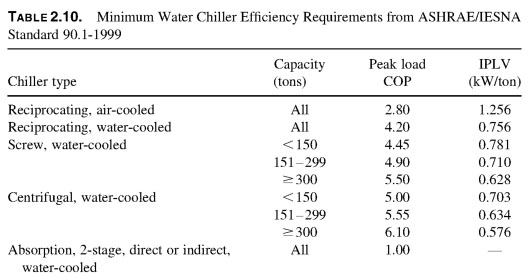Depending upon the load Capacity
One of the main chiller manufacturers estimates for a typical installation of the unit, 25% of the total ownership and maintenance costs over the life hmm related to the cost of design, procurement and installation of the unit, while 75% of the total cost of consumed energy costs and maintenance costs. Therefore, while the chiller should be adjusted peak cooling load, or designated part of peak load, it is more important to choose each chiller is to operate as efficiently as possible full range of the load that can be expected.

If hmm plant should consist of one hmm, we need only choose the cooler to meet the peak load on the cooling system, and then select the most efficient cooler (the chiller with the lowest IPLV or NPLV) within the available funds. But when multiple chillers, which will be chosen, the choice of each chiller is becoming more complex. But, the basic rule is as close as possible to meet the opportunities to load through to full load profile.
As discussed in C.
2.1, it is usually desirable to have multiple chillers available to meet the cooling load on the chilled water system. There are several aspects that must be considered when choosing chillers) for the system:
1. Type of compressorpeak load cooling below 100-125 t, rotary compressor coolers expensive and only one chiller can be used because this is the minimum capacity available for this type of compressor. Thus, the only choice is to use a compressor.
For chillers less than about 20 tons, the only way) is to use several, modular water chillers, which are available in the 2 - 10-ton capacity range. For large capacities, several piston compressors are used for one hmm, with four compressors used in 100-125-tonnes. In fact, since each compressor can be arranged independent refrigerant circuit, this arrangement provides the same reliability and redundancy) as a system, and is quite acceptable.
Between 100 and 200 tons peak cooling load two or more reciprocating compressor chillers can be used. Over 200 tons, rotary compressor systems begin to become cost effective.
2. Condensation Mediumpeak load cooling below 100-125 t, capital expenditures and increase maintenance requirements for water cooling system are seldom justified and cooler(s) will be air cooled. Above 200 tons peak cooling load, and with the use of rotary compressor refrigeration units, in addition cooling tower system to provide for water-cooled condenser be justified. Between 100 and 200 tons peak cooling load, it becomes a matter of owner's ability to cope with the financial requirements of a cooling tower system, the owner of preferred shares (if any), and the capital of the available funds.
3. Symmetrical Chiller CapacityIn this approach, all chillers are designed for equal opportunities. The number of chillers and, thus, the size of the chiller module is based on the minimum expected load. Once the plant load decreases to a level below the capacity of a single hmm, we want hmm work effectively in the region (thatE., above 30% of capacity) as long as possible.
For example, a building with a peak load of the cooling 750 tons and the minimum load on the cooling system 100 tons could be served by three chillers, each with a capacity of 250 thousand tons. 100 tons, one chiller will operate at 40% capacity, which is still in the framework of the effective region.
There were two 375 tons were selected chillers, last chiller on line will work for 27% of its capacity to meet the minimum needs in cold requirement.
In this example, if the minimum load on the cooling system was 20 tons, even 250 tons hmm would not be able to fully answer. Because hmm minimum capacity, as a rule, about 15% of the peak power, hmm would cycle off in the framework of its internal control, when the load has dropped below 40 tons.
4. Asymmetrical Chiller Capacityno engineering rule, which says that all chillers in) the system must be the same size. Although there may be some benefits of service (common parts and other), different size, chillers can be operated together.
In the previous example, 750 peak load was met with 600 - and 150-ton chiller. As chillers would work to produce 750 tons at maximum load, but less hmm would meet the minimum load acting on 50% of peak capacity, which, as a rule, a very efficient operating point.
Table 2.11 gives the load, depending on the power relations for symmetric and asymmetric examples. Asymmetric arrangement results in potentially reduces operating costs and the ability to meet the following minimum requirements in the cold. If one unit fails with symmetrical design, two-thirds of the peak power is still available. However, if the 600 tons chiller in an asymmetrical arrangement fails, only 20% of capacity of the plant.
Another common arrangement of the asymmetric-60/40 split with two chillers. In this case, one chiller is designed for 40% of the load, while the large hmm designed for 60% of the load. In many applications this separation allows greater capacity for load matching and performance improvement...
|

